By Lee Belbin (Atlas of Living Australia) and Norm McKenzie (Department of Environment and Conservation, Western Australia)
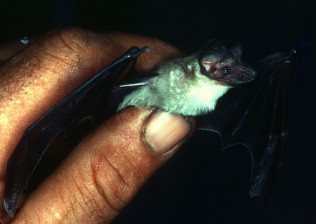
Mangroves are a much maligned group of trees. Yes, most of the time they do not make for a comfortable human environment. In mangroves, you could be up to your neck in mud being bitten by clouds of sand flies and eyeing a 5m croc (who is eying you) in 48 degrees Celsius and 100% humidity. Maybe that’s why developers like to clear mangroves for resorts while miners like to bulldoze them to create ports. But, they are crèches for many fish species and a host to many other species, one of which was the target of our safari.
Our ‘Snark’ for this trip was the bat species Morphopterus loriae cobourgiana (Ml for short). Its common names include Little Northern Scurrying Bat and Little Scurrying Bat. This, as you may have gathered, Morphopterus is a mangrove bat. It is small (about 25cm wingspan and 7-9gms), somewhat acrobatic and insectivorous (it eats bugs, but nowhere near enough).
Why were we looking for Ml? Its Western Australian population depends on the mangroves and mangroves in this region of Australia are under consistent threat. Each little patch of mangrove that gets cleared is a little patch but it all adds up to significant loss of habitat over a human lifetime. Mining companies operating in the Pilbara can provide funding that may help to conserve species such as Ml whose habitats are under threat.
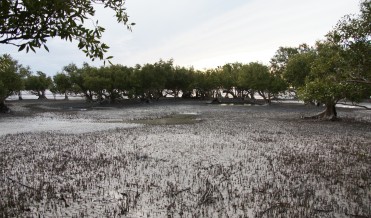
Ml can be found in mangroves from Exmouth Gulf to King Sound in the northwest of Western Australia and near-coastal areas of the ‘Top End’ in the Northern Territory. We didn’t fly up to Exmouth and rent a 4WD, no. We drove from Perth to Exmouth Gulf via Carnarvon then on up to Derby. This is about 2600 kilometres, which is a ‘decent’ drive by Western Australian standards. The positive side of this craziness is that we get visit six different mangrove patches and to see a large number of ecosystems and landscapes on the way and some of the fauna and flora that they contain.
Norm McKenzie is a bat expert. What this means is that he dreams about bats and that any conversation will eventually involve bats. If you want to know about bats, Norm is your man. It’s grand that we have such people, but sad that most would only glean a little of his knowledge by wading through the usual scientific papers (see References).
Norm knows a lot about Ml, but if money was to be spent on conserving it, there were gaps in knowledge that needed to be filled. One of these gaps was to find out where Ml was in summer. As with any trip like this, you also try to address a few other issues, if you can.
I wanted to test out the Atlas of Living Australia’s mobile app called OzAtlas. This is an application for Apple and Android mobile devices for entering basic observations of species into the Atlas database.
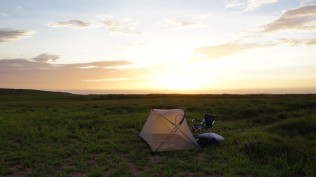
To anyone interested in scenery and the things that it contains, this was a special trip – one that I (Lee Belbin) have wanted to do for nearly 20 years. If that wasn’t special enough, it was extra-special in that you don’t get to travel with one of Australia’s authorities not of only bats, but anything zoological in the western part of Australia.
We headed north from Perth on February 5th 2013 in the middle of the warmest, stickiest part of summer. The requisites for such a trip are in priority order:
- A comfortable and reliable 4WD. We had a petrol Subaru Forester. We were going into some remote areas of Australia’s northwest and, while not rock hopping too much, you need something that can get you in and out of some rough or boggy places.
- Air conditioning. Yes, naturalists put up with the worst the world has to dish out. Norm and I are old (and often cantankerous). On this trip, we needed a refuge from the intense heat every now and again. A good car a/c was wonderful. It made the long drives much more pleasant.
- A mosquito and sand fly dome. You don’t need a tent. You need Airy with a capital A. This would be an escape from the insects that we would have in abundance. If you want to sleep and there is no motel, the domes were insurance against insanity.
- Long sleeve shirt, long pants, socks and shoes that can handle the worst mud, coral, mangroves, and an insect mesh for your head. More insurance.
- A good car fridge. You need water, lots of water, and cold is better. You also need some food in case you get stuck somewhere remote for a few days.
- A (working) satellite phone for safety. We would be in mobile phone range about 10% of the time.
- Scientific instruments to detect and record our bat. Our species, like most other bats and many Australian fury things, is nocturnal. Even with good spotlights, identifying a fast flying bat, even by an expert, is a hard call. We needed some sophisticated electronics that would record Ml‘s high frequency echolocation call sequences, to distinguish them from calls by other bat species. A notebook and pen is however still a must.
- A comfortable chair. This was vital for surveying the bats over a 3 hour period and also handy when you want to have something to eat, or occasionally watch the wonderful scenery.
- Head torches: Good ones. These are needed to help identify the bats, and to stop yourself from being impaled by branches and falling to your death on sharp coral limestone. The ideal nights for bats are dark, and as we aren’t bats, light is nice.
- Aerogard, Rid, mangrove mud (dried preferably) or equivalent. The insects in mangrove stands are bad. Really bad. Expect to gain altitude or loose blood or sanity without such measures. In some cases, nothing helps completely. It’s evolution in action.
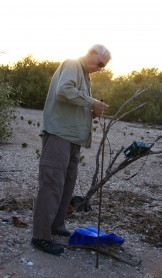
A typical day involved finding the survey site and setting up equipment and ourselves for monitoring the bats over the evening. The sites were selected from previous survey sites that covered a fair extent of Ml’s range. Some of the sites had not been visited for many years so we needed time to find them again, setup the recorders and make visual observations. In one case, we spent two hours negotiating a track only suitable for serious 4-wheel drives, only to have to turn around and find another way in. Once we found the site, we then needed to identify a good location to setup the recorder.
The echo-location ability of bats is amazing. They generate sounds between 9,000 and 160,000 hertz (cycles per second) and use different sounds for different activities. They can navigate through complex environments and they can locate and capture moving prey. Each bat has a unique profile of the frequencies and pule structure that it uses for its activities. Each bat species also has a unique airframe, including wing body, tail and ear-canard shape.
The main recorder is carefully positioned in the mangroves to reduce reflected sounds and avoid being swamped by the incoming tide. We set it up, pray to the mangrove gods and come back in the morning hoping for 10 hours of clear recording. We also had a device that divides the bat echo-location sounds by 16, pulling for example sounds at 32,000 Hz to 2,000Hz allowing our far poorer hearing to listen in. This unit is also connected to a small, high quality digital voice recorder – a check on what is about while we are listening.
Once the main recorder is setup, we make camp and wait until about 6pm. We put on our long pants and shirt, tuck pants into socks, spread Aerogard or equivalent liberally on any exposed skin, pickup chair, head torches and binoculars and find a good observation possie. And wait, with the flies.
Sometimes a group of 30 or more bats rises up and heads off to forage. At other times, we sit and wait and see and hear nothing. This is all valuable data. If the sunset is nice, it’s a bonus. If the scenery is nice, likewise. If the stars are visible, ditto. If there is a light wind to blow away a percentage of flies and mosquitoes (without being too strong to blow away the bats – or more accurately, stop them from flying), wonderful. Good company also helps. If we see bats against the evening sky to the west, eureka. It’s a game of chance with the odds in our favour thanks to Norm’s knowledge.
Bats don’t like flying when their predators (falcons, kites, eagles etc) can see them, naturally enough. There is therefore a small window of time when we can see them and their predators probably won’t. Once it is dark, and there are bats about, we begin to hear the increasingly familiar tick, tick, tick…tickticktiktikitik of Ml or other species. This is a typical sound from an Ml. With expert advice, it is surprisingly easy to get your ear ‘in’ and identify the probable species. When we hear them, we can turn on the head torches and hopefully get a visual confirmation. Flight characteristics, size and colour complement the audio identification.
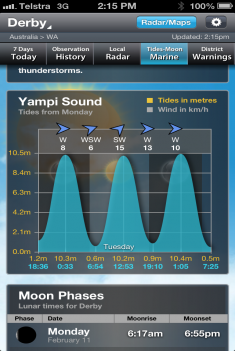
Most nights, we call it quits around 9pm. By that time, we have a fair indication of what species are around and their abundance. We had good nights, and one not so good night, but in the latter case, we got recordings of Ml on the electronics anyway.
We started the survey at the southern end of Exmouth Gulf on the mid-northwest coast and ended it at Derby in the northeast of Western Australia. In between, we surveyed mangrove stands at Onslow, Cape Keraudren, Derby and Point Torment (a fair indication of what to expect!). One night, we lost the main recorder to the waves. We estimated the tide from the marks on the shore but guessed wrong (see figure above). The tide was about 1m larger than expected due to the wind effect. The ‘waterproof’ box of electronics sadly wasn’t. It was an expensive lesson, but we still had our second recorder and our senses so all was not lost.
Our survey filled in the previous gaps in Ml’s distribution. In summer, we had low numbers in the south but high numbers in the north. In winter, greater numbers have been observed south of Cape Keraudren.
While waiting for darkness, we also identified any birds around the sites. Birds are one of the easiest of lifeforms to identify accurately, but like any species, there are always possible issues about names and features. The list of observed birds was then entered into the Atlas of Living Australia using OzAtlas. On our trip, this had to be done when we had some form of internet connection as OzAtlas currently uses the online Atlas database for species identification before adding in the new observations. A new version is being developed that will support offline recordings.
The Atlas of Living Australia requires five basic elements to form a valid observation record:
- A species name. This could be either a scientific name like our target species (Mormopterus loriae) or a common name such as “Magpie Lark”.
- A location. The more accurate the location, the better. The best way to achieve this is to use the OzAtlas application’s Google map (satellite base map) to zoom right into the position of the sighting. Spatial accuracies of < 100m are feasible.
- A date and preferably a time that the observation was made. This can be added to the notes.
How many of the species were observed? - Who did the observing?
- Optional notes. These may contain what the species was doing at the time or any uncertainties about the observation.
Many other aspects of an observation can be entered, but OzAtlas limits itself to the above. The app can also tell you what species occur within an area or show you images of species and their known spatial distribution. The usual process is to use OzAtlas to search for an observed species to check it against images and its spatial distribution. If you are confident, the observation is added directly to the Atlas. These records are subsequently checked using a range of data quality processes established by Atlas. If the observation is validated, it is available publicly.
Anyone can enter observations into the Atlas. We encourage it! Anything that helps us to know where species occur (on land or in water) – will help us to better understand the environment that supports all of us.
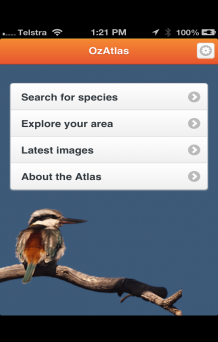
OzAtlas has been used by a wide range of people over the last year. This trip was a ‘use in anger’ exercise and didn’t disappoint. We found for example that:
- It was more difficult than it should be to enter multiple species for a single observation point. We need to greatly streamline this common field activity.
- Apply observations of species from an area list for the observation point.
- Automatically include date and time.
- Ideally, having an ability to enter records while offline with later sync to the main server.
The Atlas of Living Australia also has a far more advanced data entry application called FieldData for setting up forms for entering detailed species observations.
References
- List of Australian bats
- Adams, M., Reardon, T.R., Baverstock, P.R. and Watts, C.H.S. (1988). Electrophoretic resolution of species boundaries in Australian Microchiroptera. IV. The Molossidae (Chiroptera). Aust J. Biol. Sci. 41, 315-326.
- McKenzie, N.L. and Start, A.N. (1989). Structure of bat guilds in mangroves: environmental disturbance and determinism. Pp 167-178. In: Morris, D.W., Abramsky, Z., Fox, B.J. and Willig, M.R. (eds) Patterns in the Structure of Mammalian Communities. Texas Tech University Press, Lubbock, Texas.
- McKenzie, N.L. (1995). Little Northern Freetailed-bat, Mormopterus loriae cobourgiana (Johnson 1959). Pp 482-483. In: Strahan, R. The Mammals of Australia. Reed Books, Australia.
- Thomson, B.G., 1991. A Field Guide to Bats of the Northern Territory. Darwin: Conservation Commission of the Northern Territory.